wheel PORSCHE 911 TARGA4 2013 6.G Information Manual
[x] Cancel search | Manufacturer: PORSCHE, Model Year: 2013, Model line: 911 TARGA4, Model: PORSCHE 911 TARGA4 2013 6.GPages: 54, PDF Size: 8.37 MB
Page 6 of 54

1013
Iconic style | The 911 Targa evolution
Over the course of a lifetime, we gather
a lot of memories, some of which play
out in our minds like films. With emotion
in stereo and Technicolor images of
forms and role models which have left
a lasting impression on us.
One of these films features the
9 11 Ta r g a . It begins in 1965 in Zuffen -
hausen – where else? It was here that
the original Targa with roll- over bars
and removable folding roof – Porsche’s
ingenious solution to American safet y
regulations – was created. Derived
from the 9 11 Coupé, the 9 11 Targa was
developed in response to increasing
demand for an open-top version of the
9 11
which could also offer the same
levels of comfort and safet y as a
closed-top model.
The Targa name alone is the stuff of
legends. It originates from the famous
endurance race held in Sicily, the Targa
Florio. The course was notorious for
its tight bends which the comparatively
compact Porsche race cars of the 60s
were able to use to their advantage,
Never restrain the yearnings of time travel.
The 911 Targa evolution.
chalking up a number of victories
in the process. ‘Targa’ means ‘shield’
in Italian and thus the name also
became symbolic of the ‘protective
shield’ provided by the innovative
safet y concept of the 9 11 Ta r g a .
The most distinctive, style-defining
feature of the Targa is its aluminium bar
with three fins and ‘ targa’ logo. Over
the years, this design has left a lasting
impression on the car’s drivers and
fans. In 1975, the silver bar was replaced
with a black one for the ‘G -series’
version of the 911 Targa, whilst the
subsequent 964 series saw the launch
of the first all-wheel drive 911 Targa. In
1995, for the fourth generation of the
911, the Targa got a completely new
roof concept: an electrically operated
glass roof with aluminium trim strips
running along the sides. Even though
this form of the
9 11 Targa underwent
further evolutionary development in
subsequent generations, its st ylistic
integrity was maintained, resulting in an award-winning design which conveyed
a feeling of open-top driving, even with
the roof closed.
The captivating saga of the 911 Targa
continues, even today. This current
episode features the return of the iconic
Targa bar, innovative roof technology,
that very special open-air driving
sensation and an exceptional level of
comfort. Once again, it is being played
out on the road. And the ending? Well,
that ’s been left open, of course.
Page 10 of 54

2120
A sports car is defined by its power. A
Porsche by efficient power. And the new
911 Targa 4 models by efficient sport y
power delivered to the road in st yle.
A 3.4-litre 6- cylinder boxer engine with
a power output of 257 kW (350 hp)
accelerates the new 911 Targa 4 from
0 – 62 mph in just 5.2 seconds.
The new 911 Targa 4S is powered by a
3.8-litre 6-cylinder boxer engine with
an output of 294 kW (400 hp). When
combined with the optional Porsche
Doppel kupplung (PDK), this model takes
just 4.6 seconds to reach the 62 mph
barrier.
The enhanced Porsche Traction
Manage ment (PTM) ensures the new
911 Targa 4 models can tackle any t ype
of weather and any t ype of road surface.
It precisely and directly regulates the
distribution of the drive forces to the
front and rear axles (see page 40). A
visible indicator of the all-wheel-drive
system is the seamless taillight strip.
Other distinguishing features include
the wider body and broad rear t yres –
295 mm on the new 911 Targa 4 and
305 mm on the new 911 Targa 4S.
Some choose to regard the new
911 Targa 4 models as design objects.
But their performance potential soon
makes it clear that they are far too good
to be kept just for show.
For fuel consumption and CO
2 emissions, please refer to page 103.
Defining style | 911 Targa 4 and 911 Targa 4S
The longer dreams last,
the more intense they become.
The new 911 Targa 4 and new 911 Targa 4S.
Page 11 of 54
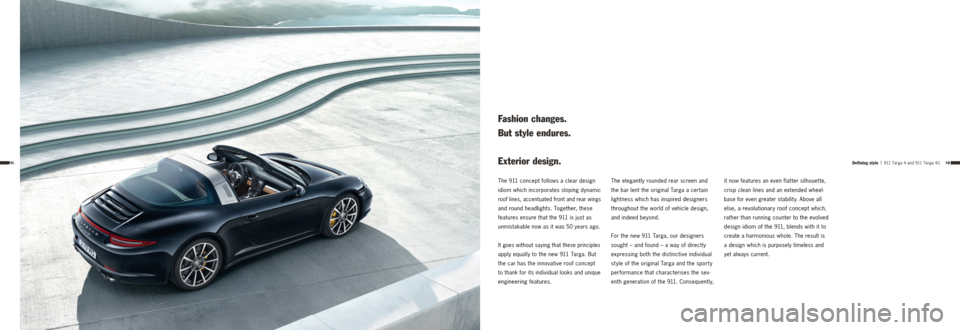
2322
The 911 concept follows a clear design
idiom which incorporates sloping dynamic
roof lines, accentuated front and rear wings
and round headlights. Together, these
features ensure that the
9 11 is just as
unmistakable now as it was 50 years ago.
It goes without saying that these principles
apply equally to the new 911 Targa. But
the car has the innovative roof concept
to thank for its individual looks and unique
engineering features. The elegantly
rounded rear screen and
the bar lent the original Targa a certain
lightness which
has inspired designers
throughout
the world of vehicle design,
and indeed beyond.
For the new 911 Targa, our designers
sought – and found – a way of directly
expressing both the distinctive individual
st yle of the original Targa and the sport y
performance that characterises the sev -
enth generation of the 911. Consequently,
Fashion changes.
But style endures.
Exterior design.
it now features an even flat ter silhouet te,
crisp clean lines and an extended wheel -
base for even greater stabilit y. Above all
else, a revolutionary roof concept
which,
rather than running counter
to the evolved
design idiom of the
9 11, blends with it to
create a harmonious whole. The result is
a design which is
purposely timeless and
yet always current.
Defining style | 911 Targa 4 and 911 Targa 4S
Page 12 of 54
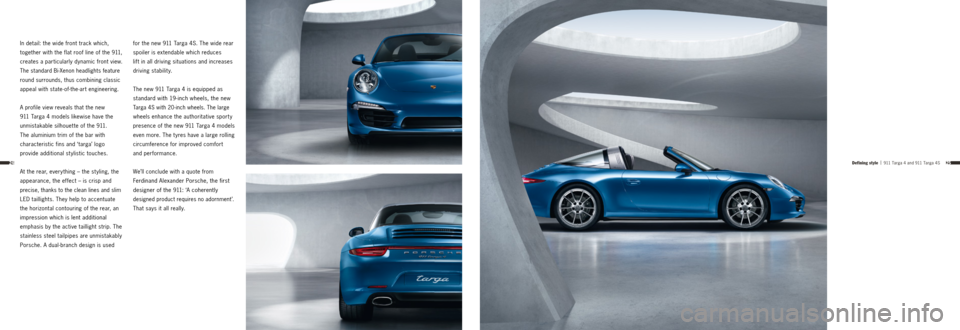
2524
In detail: the wide front track which,
together with the flat roof line of the 911,
creates a particularly dynamic front view.
The standard Bi-Xenon headlights feature
round surrounds, thus combining classic
appeal with state-of-the-art engineering.
A profile view reveals that the new
911 Targa 4 models likewise have the
unmistakable silhouette of the 911.
The aluminium trim of the bar with
characteristic fins and ‘ targa’ logo
provide additional stylistic touches.
At the rear, every thing – the st yling, the
appearance, the effect – is crisp and
precise, thanks to the clean lines and slim
LED taillights. They help to accentuate
the horizontal contouring of the rear, an
impression which is lent additional
emphasis by the active taillight strip. The
stainless steel tailpipes are unmistakably
Porsche. A dual-branch design is used for the new 911 Targa 4S. The wide rear
spoiler is extendable which reduces
lift in all driving situations and increases
driving stability.
The new 911 Targa 4 is equipped as
standard with 19-inch wheels, the new
Targa 4S with 20 -inch wheels. The large
wheels enhance the authoritative sport y
presence of the new 911 Targa 4 models
even more. The t yres have a large rolling
circumference for improved comfort
and performance.
We’ll conclude with a quote from
Ferdinand Alexander Porsche, the first
designer of the
9 11: ‘A coherently
designed product requires no adornment’.
That says it all really.
Defining style | 911 Targa 4 and 911 Targa 4S
Page 14 of 54
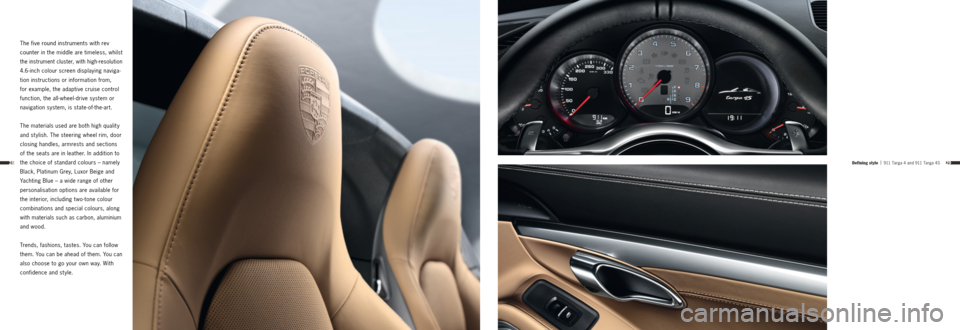
2928
The five round instruments with rev
counter
in the middle are timeless, whilst
the instrument cluster, with high-resolution
4.6-inch colour screen displaying naviga -
tion instructions or information from,
for example, the adaptive cruise control
function, the all-wheel-drive system or
navigation system, is state- of-the-art.
The materials used are both high qualit y
and st ylish. The steering wheel rim, door
closing handles, armrests and sections
of the seats are in leather. In addition to
the choice of standard colours – namely
Black, Platinum Grey, Luxor Beige and
Yachting Blue – a wide range of other
personalisation options are available for
the interior, including two-tone colour
combinations and special colours, along
with materials such as carbon, aluminium
and wood.
Trends, fashions, tastes. You can follow
them. You can be ahead of them. You can
also choose to go your own way. With
confidence and st yle.
Defining style | 911 Targa 4 and 911 Targa 4S
Page 20 of 54
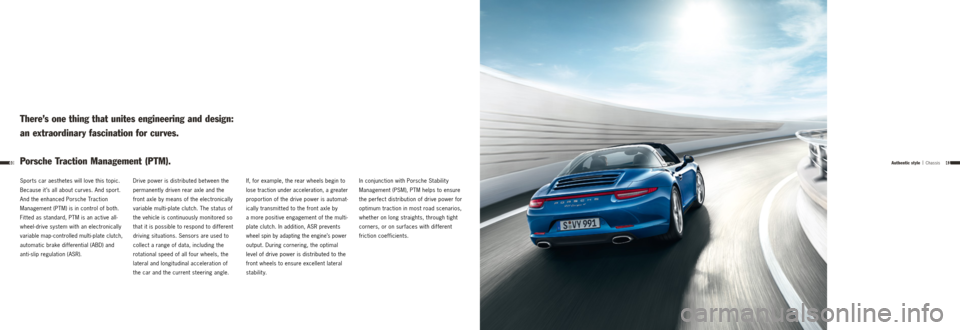
4140Authentic style | Chassis
Sports car aesthetes will love this topic.
Because it ’s all about curves. And sport.
And the enhanced Porsche Traction
Management (PTM) is in control of both.
Fit ted as standard, PTM is an active all-
wheel-drive system with an electronically
variable map-controlled multi-plate clutch,
automatic brake differential (ABD) and
anti-slip regulation (ASR). Drive power is distributed bet ween the
permanently driven rear axle and the
front axle by means of the electronically
variable multi-plate clutch. The status of
the vehicle is continuously monitored so
that it is possible to respond to different
driving situations. Sensors are used to
collect a range of data, including the
rotational speed of all four wheels, the
lateral and longitudinal acceleration of
the car and the current steering angle. If, for example, the rear wheels begin to
lose traction under acceleration, a greater
proportion of the drive power is automat -
ically transmit ted to the front axle by
a more positive engagement of the multi-
plate clutch. In addition, ASR prevents
wheel spin by adapting the engine’s power
output. During cornering, the optimal
level of drive power is distributed to the
front wheels to ensure excellent lateral
stability. In conjunction with
Porsche Stability
Management (PSM), PTM helps to ensure
the perfect distribution of drive power for
optimum traction in most road scenarios,
whether on long straights, through tight
corners, or on surfaces with different
friction coefficients.
There’s one thing that unites engineering and design:
an extraordinary fascination for curves.
Porsche Traction Management (PTM).
Page 21 of 54
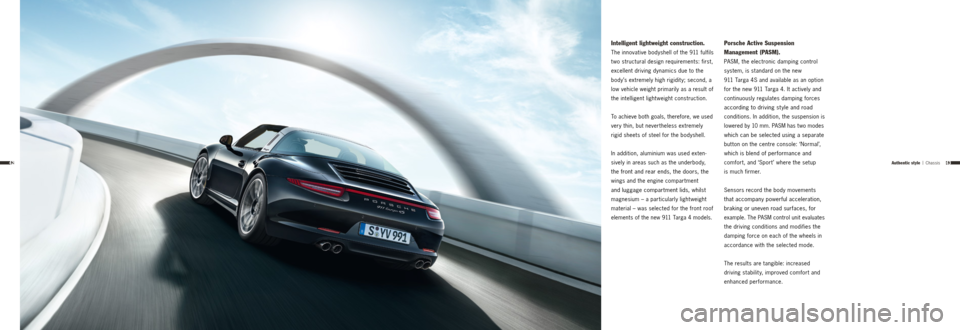
4342
Intelligent lightweight construction.
The innovative bodyshell of the 911 fulfils
t wo structural design requirements: first,
excellent driving dynamics due to the
body’s extremely high rigidit y; second, a
low vehicle weight primarily as a result of
the intelligent lightweight construction.
To achieve both goals, therefore, we used
very thin, but nevertheless extremely
rigid sheets of steel for the bodyshell.
In addition, aluminium was used exten -
sively in areas such as the underbody,
the front and rear ends, the doors, the
wings and the engine compartment
and luggage compartment lids, whilst
magnesium – a particularly lightweight
material – was selected for the front roof
elements of the new 9 11 Targa 4 models.
Authentic style | Chassis
Porsche Active Suspension
Management (PASM).
PASM, the electronic damping control
system, is standard on the new
911 Targa 4S and available as an option
for the new 911 Targa 4. It actively and
continuously regulates damping forces
according to driving st yle and road
conditions. In addition, the suspension is
lowered by 10 mm. PASM has t wo modes
which can be selected using a separate
button on the centre console: ‘Normal’,
which is blend of performance and
comfort, and ‘Sport ’ where the setup
is much firmer.
Sensors record the body movements
that accompany powerful acceleration,
braking or uneven road surfaces, for
example. The PASM control unit evaluates
the driving conditions and modifies the
damping force on each of the wheels in
accordance with the selected mode.
The results are tangible: increased
driving stability, improved comfort and
enhanced performance.
Page 22 of 54

4544
Porsche Dynamic Chassis Control
(PDCC).
PDCC – available as an option for the
new 911 Targa 4S – is an active anti-roll
system that suppresses lateral body
movement during cornering manoeuvres.
In addition, it minimises the lateral
instabilit y of the vehicle on uneven ground.
The results are improved dynamic perfor-
mance and increased ride comfort at all
speeds, as well as optimised turn-in and
stable load transfer characteristics. In simple terms, the t yres and vehicle
hold the road bet ter and you can steer
through the corners faster and in a more
relaxed manner. PDCC is thus set ting
standards for handling performance, ride
comfort and driving pleasure.
Electromechanical power steering.
It ’s a known fact that a stretch of straight
road heightens your anticipation of the
next bend. However, statistics show that
a car drives in a straight line 90
% of
the time. Our engineers saw the energy-
saving potential that this offered. So,
unlike conventional hydraulic pumps, the electric motor of the electromechanical
power steering system uses energy
only when the steering wheel is actually
turned. The absence of hydraulic fluid
also makes the system more beneficial
to the environment.
As far as the other 10 % is concerned,
we’re optimally prepared, as the steering
system is t ypically Porsche. It features
a variable steering ratio and responds
sensitively and directly whilst providing
customary agilit y, a high degree of
comfort and precisely selected feedback
from the road.
Authentic style | Chassis
Page 23 of 54
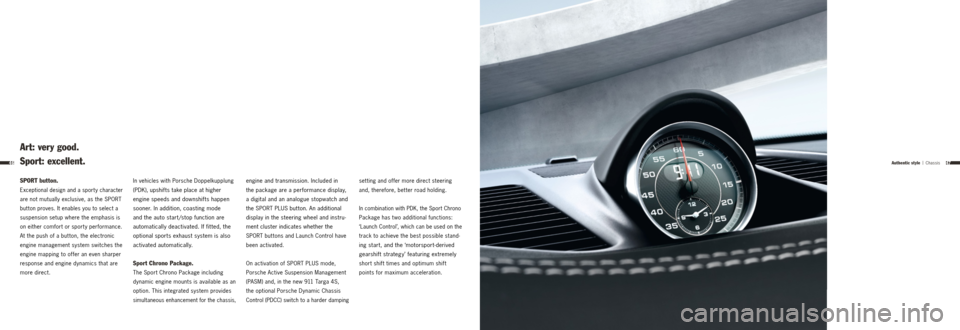
4746
SPORT button.
Exceptional design and a sport y character
are not mutually exclusive, as the SPORT
but ton proves. It enables you to select a
suspension setup where the emphasis is
on either comfort or sport y performance.
At the push of a but ton, the electronic
engine management system switches the
engine mapping to offer an even sharper
response and engine dynamics that are
more direct. In vehicles with
Porsche Doppelkupplung
(PDK), upshifts take place at higher
engine speeds and downshifts happen
sooner. In addition, coasting mode
and the auto start/stop function are
automatically deactivated. If fitted, the
optional sports exhaust system is also
activated automatically.
Sport Chrono Package.
The Sport Chrono Package including
dynamic engine mounts is available as an
option. This integrated system provides
simultaneous enhancement for the chassis,
Art: very good.
Sport: excellent.
engine and transmission. Included in
the package are a performance display,
a digital and an analogue stopwatch and
the SPORT PLUS but ton. An additional
display in the steering wheel and instru
-
ment cluster indicates whether the
SPORT but tons and Launch Control have
been activated.
On activation of SPORT PLUS mode,
Porsche Active Suspension Management
(PASM) and, in the new 911 Targa 4S,
the optional Porsche Dynamic Chassis
Control (PDCC) switch to a harder damping set ting and offer more direct steering
and, therefore, better road holding.
In combination with PDK, the Sport Chrono
Package has two additional functions:
‘Launch Control’, which can be used on the
track to achieve the best possible stand -
ing start, and the ‘motorsport-derived
gearshift strategy’ featuring extremely
short shift times and optimum shift
points for maximum acceleration.
Authentic style | Chassis
Page 24 of 54
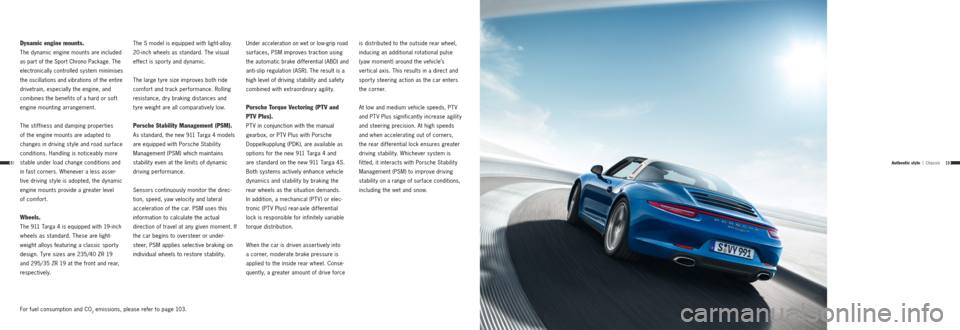
4948
Dynamic engine mounts.
The dynamic engine mounts are included
as part of the Sport Chrono Package. The
electronically controlled system minimises
the oscillations and vibrations of the entire
drivetrain, especially the engine, and
combines the benefits of a hard or soft
engine mounting arrangement.
The stiffness and damping properties
of the engine mounts are adapted to
changes in driving st yle and road surface
conditions. Handling is noticeably more
stable under load change conditions and
in fast corners. Whenever a less asser -
tive driving st yle is adopted, the dynamic
engine mounts provide a greater level
of comfort.
Wheels.
The 9 11 Targa 4 is equipped with 19-inch
wheels as standard. These are light-
weight alloys featuring a classic sport y
design. Tyre sizes are 235/40 ZR 19
and 295/35 ZR 19 at the front and rear,
respectively.
For fuel consumption and CO
2 emissions, please refer to page 103. The S model is equipped with light-alloy
20-inch wheels as standard. The visual
effect is sport y and dynamic.
The large t yre size improves both ride
comfort and track performance. Rolling
resistance, dry braking distances and
t yre weight are all comparatively low.
Porsche Stability Management (PSM).
As standard, the new 9 11 Targa 4 models
are equipped with
Porsche Stability
Management (PSM) which maintains
stabilit y even at the limits of dynamic
driving performance.
Sensors continuously monitor the direc -
tion, speed, yaw velocit y and lateral
acceleration of the car. PSM uses this
information to calculate the actual
direction of travel at any given moment. If
the car begins to oversteer or under -
steer, PSM applies selective braking on
individual wheels to restore stability.
Under acceleration on wet or low-grip road
surfaces, PSM improves traction using
the automatic brake differential (ABD) and
anti-slip regulation (ASR). The result is a
high level of driving stabilit y and safet y
combined with extraordinary agility.
Porsche Torque Vectoring (PTV and
PTV Plus).
PTV in conjunction with the manual
gearbox, or PT V Plus with Porsche
Doppelkupplung (PDK), are available as
options for the new 911 Targa 4 and
are standard on the new 9 11 Targa 4S.
Both systems actively enhance vehicle
dynamics and stabilit y by braking the
rear wheels as the situation demands.
In addition, a mechanical (PT V) or elec -
tronic (PT V Plus) rear-axle differential
lock is responsible for infinitely variable
torque distribution.
When the car is driven assertively into
a corner, moderate brake pressure is
applied to the inside rear wheel. Conse -
quently, a greater amount of drive force is distributed to the outside rear wheel,
inducing an additional rotational pulse
(yaw moment) around the vehicle’s
vertical axis. This results in a direct and
sport y steering action as the car enters
the corner.
At low and medium vehicle speeds, PT V
and PT V Plus significantly increase agilit y
and steering precision. At high speeds
and when accelerating out of corners,
the rear differential lock ensures greater
driving stability. Whichever system is
fitted, it interacts with Porsche Stability
Management (PSM) to improve driving stabilit y on a range of surface conditions,
including the wet and snow.
Authentic style | Chassis